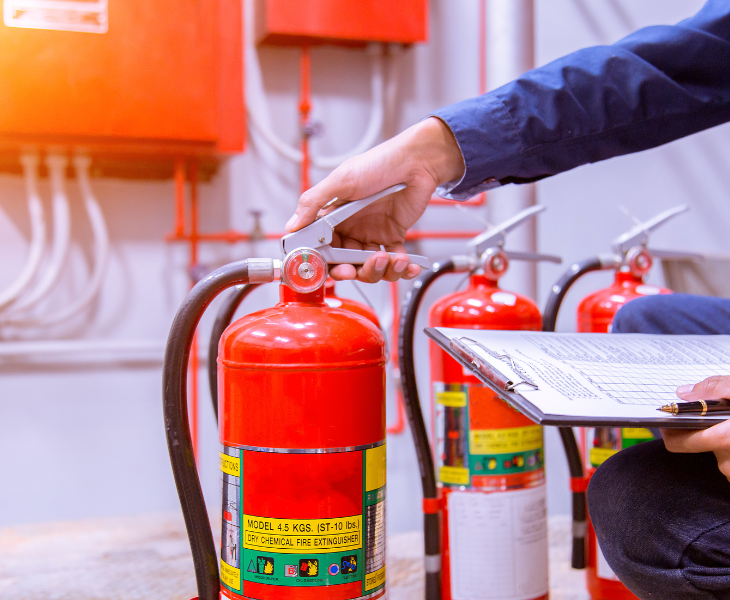According to research by Fire and Safety Australia, workers around the country are unprepared to deal with workplace
fires, with fewer than half of the workers polled feeling confident about using a fire extinguisher. What’s more, the research showed that only 25% of study participants could locate their nearest fire extinguisher, and only 13% were aware that there were different categories of fire extinguisher.
To ensure fire safety in the workplace, it’s imperative that all staff understand the proper use and location of fire safety
equipment on the premises. It’s also vitally important that the equipment is suitable for the fire being fought.
5 Types of Fire Extinguishers
It is important to familiarise yourself with which fire extinguisher type can be used for which type of fuel. Using the incorrect type may not work or may cause a dangerous chemical reaction (for example, using water based fire extinguishers on a Class B, F, or electrical fires). In other cases, using the wrong fire extinguisher means that the
fire can reignite after apparently being successfully extinguished.
WATER
Suitable for Class A fires only, and must never be used in any other instance, as it may cause a dangerous reaction. The Water Fire Extinguisher involves ordinary combustible materials such as wood, paper, and textiles. They are typically filled with water and work by cooling the fire and removing heat, one of the three elements needed for fire to sustain itself (heat, fuel, and oxygen).
Applications:
- Ideal for use in homes, offices, schools, and other environments where Class A fire risks are prevalent.
- Suitable for environments where combustible materials like furniture, paper, and wood are common.
FOAM
Must only be used for Class A and B fires, not any other type of fire. Foam fire extinguishers are versatile and are designed for Class A fires (combustibles like paper and wood) and Class B fires (flammable liquids such as petrol, oils, and alcohol). These extinguishers work by smothering the fire and sealing the surface of the burning material, preventing oxygen from fuelling the flames further.
Applications:
- Effective in environments where both combustible materials and flammable liquids are present, such as garages, workshops, and industrial settings.
- Suitable for kitchens, as they can extinguish cooking oils and other liquid-related fire risks (though they are not ideal for deep-fat fryer fires).
DRY POWDER
This is effective on Class B and C fires. A new multipurpose dry chemical type is also effective on Class A fires as well. Powder fire extinguishers, also known as dry chemical extinguishers, are highly versatile and can be used for Class A (combustible materials), Class B (flammable liquids), and Class C (flammable gases) fires. Additionally, they are safe to use on electrical fires. The dry powder works by creating a barrier between the fuel and oxygen or by interrupting the chemical reaction of the fire.
Applications:
- Ideal for environments where various fire risks are present, such as construction sites, manufacturing facilities, workshops, and gas stations.
- Can be used to extinguish electrical fires, making them suitable for use in areas with machinery, computers, and other electronic equipment.
CARBON DIOXIDE
These can be used on Class B and C fires, and are usually ineffective on Class A fires. They work by displacing oxygen and cooling the fire, cutting off the oxygen supply and reducing the heat. CO2 is a non-conductive, non-corrosive gas, making these extinguishers particularly effective for use around electrical equipment.
Applications:
- Ideal for offices, server rooms, and areas where electrical fires are a primary concern.
- Suitable for use on Class B fires, including those involving petrol, oils, and solvents.
WET CHEMICALS
For Class F fires, these are designed to put out deep fat fryers fires in modern commercial kitchens. Some may also be used to put out class A fires in commercial kitchens, which involve cooking oils and fats, commonly found in deep fat fryers in commercial kitchens. They work by cooling the flames and chemically reacting with the hot oil to form a soapy layer that seals the surface, preventing re-ignition.
Applications:
- Essential in commercial kitchens, restaurants, and food preparation areas where deep-fat fryers and other high-risk cooking equipment are used.
- Can also be used on Class A fires involving combustibles like paper and wood, although this is not their primary purpose.
Fire Blankets
A fire blanket is a safety device designed to extinguish small fires by smothering them. Fire blankets are typically made from fire-resistant fiberglass or wool, treated with flame-retardant chemicals. Blankets work by cutting off the fire’s oxygen supply, effectively putting out the flames. To use a fire blanket, it should be carefully placed over a fire, completely covering it to starve the fire of oxygen. Fire blankets are especially useful for kitchen fires involving oil or grease. They can also be wrapped around a person for protection during a fire emergency.
Fire blankets are versatile safety tools with several key uses:
- Smothering Small Fires: Kitchen fires involving oil or grease can be dangerous to extinguish with water.
- Personal Protection: A fire blanket can be wrapped around a person to protect them from flames and high heat.
- Covering Burning Objects: Cover and extinguish a burning object, such as a waste bin or small electrical fire.
- Extinguishing Clothing: Smother fires on clothing to prevent burns. Some types of fire extinguisher can cause irritation or damage is used directly on skin.

